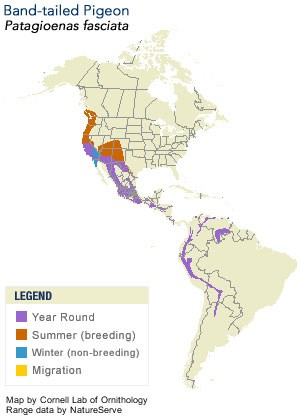What is a band tailed pigeon?
The band-tailed pigeon (Columba fasciata) is a large member of the family columbidae; which includes the ubiquitous rock dove and the Eurasian collared dove. It takes its name from the distinctive black band on its tail feathers (Sibley, 2003). Although rather shy they are easily seen at bird feeders.
How to spot a band-tailed pigeon.
The most useful feature for distinguishing band tailed pigeons from other pigeons and doves are its yellow bill and feet, which are unique to the species (Sibley, 2003). It has a lavender grey body and dark wingtips. The adults have a slightly redder breast and a white stripe with and iridescent patch under it on the back of their neck. Thereare no plumage differences between male and female birds (Sibley, 2003). Since band-tailed pigeons are big it’s easy to spot a flock of them when they land on or take off from a tree. You can also “spot” a band-tailed pigeon by listening for its call, a deep “whoo-hoo” that can be easily mistaken for an owl call (Sibley, 2003).
Figure 1: Band-tailed pigeon call from Madera Canyon 23 Apr 2005 (Deviche P. 2005)

Figure 2: An adult band tailed pigeon. Note the yellow legs & bill and the distinctive dark band on its tail (http://nathistoc.bio.uci.edu/birds/columbiformes/Columba%20fasciata/index.htm)
You can increase your chances of seeing a band-tailed pigeon by attracting them to your backyard. Band tailed pigeons will happily eat commercial bird seed mixes, but they also like to eat the eat buds, flowers, seeds, and fruit from many native trees and bushes (Sanders, 2014). Planting Kinnickinnick bushes, elderberry bushes, arbutus trees and dogwood trees will provide plenty of food and shelter for band tailed pigeons and other birds (Anderson, 1990). Providing clean, fresh water will provide birds with a place to drink and bathe, especially in the summer months when natural water sources are scarce. There is no need for a fancy bird bath; a basin placed on a stump works just fine. And finally keeping cats indoors is always a good idea if you want to attract wild birds.
Figure 3: A video showing Band-tailed pigeon feeder behavior. Note the lack of neck markings on the juvenile bird on the right feeder.
Where does it live?
Unlike its close relative the passenger pigeon, band tailed pigeons are not widely distributed (Jarvis and Passmore , 1992). They only live in the coniferous forests in mountainous zones and the coastal fog forests of western North and South America (Jarvis and Passmore, 1992). They will also frequent suburban parks, orchards, and back yards in their range in search of food (Jarvis and Passmore, 1992).

Figure 4: A map showing the range of band-tailed pigeons (Cornell University, ND)
How does it behave?
Band tailed pigeons will travel long distances to find food and water, and food availability plays a big part in determining where they live and in what abundance (Sanders, 2014). They frequently visit areas with large mineral deposits to get important minerals like calcium and salt that they otherwise wouldn’t get through their normal diet (Jarvis and Sanders, 2000). Whether or not they migrate is dependent on where they live; southern birds don’t migrate, but northern birds migrate on a regular schedule (Passmore and Jarvis, 1992). They form flocks of up to 300 birds, likely to protect them from predators like falcons, hawks, and owls (Cornell University, ND).
What is its breeding behaviour like?
Band-tailed pigeons breed from May to August. A female will usually only lay 1 egg per clutch, but as it takes only 45-50 days to raise a chick, the pair will raise more than 1 clutch per season. Like many birds both the male and female take turns incubating the eggs and feeding the chicks. Band tailed pigeons feed their young with pigeon milk; a nutritious liquid that is made in the crop (a part of a birds digestive system it uses to store food) of both male and female doves and pigeons (Dobkin et al, 1988).
What threats does it face?
People hunt band tailed pigeons for food and sport throughout their range, but this isn’t thought to have a serious affect on their population numbers (Jarvis and Passmore, 1992). The major threats to band tailed pigeons are limited food and a disease called trichomoniasis, which is caused by a single celled parasite that was brought to North America by introduced pigeons and doves (Jarvis and Passmore, 1992). The species at risk act considers the band tailed pigeon to be special concern (Cornell University, ND).
References
Anderson, E. Native Plants that Attract Birds to Your Garden. [Internet]. 1990[cited 2015 Oct 26]. East Bay Regional Park District. Available from http://www.nativeplants.org/wp-content/uploads/2015/05/attractbirds.pdf
Cornell University. [internet]. 2015 [cited 2015 Oct 26]. Cornell Lab of Ornithology. Available from https://www.allaboutbirds.org/guide/Band-tailed_Pigeon/lifehistory
Deviche P. Band-tailed Pigeon. [Internet]. 2005 Apr 23 [cited 2015 Oct 26]. AZFO Bird Sounds Library. Available from http://www.azfo.org/soundlibrary/sounds_tax.html.
Ehrlich, P. R., Dobkin, D. S., Wheye, D. Bird Milk. [Internet]. 1988 [cited 2015 Oct 26]. Stanford University. Available from https://web.stanford.edu/group/stanfordbirds/text/essays/Bird_Milk.html
Jarvis, R. L., Passmore M. F. 1992. Ecology of Band-tailed Pigeons in Oregon. U.S. Fish and Wildlife Services [internet] 1992 [cited 2015 Oct 26]. 1-38. Available from http://babel.hathitrust.org/cgi/pt?id=mdp.39015086475400;view=1up;seq=42
Sanders, T. A., Jarvis, R. L. 2000. Do Band-Tailed Pigeons Seek a Calcium Supplement at Mineral Sites. The Condor. [internet] 2000[cited 2015 Oct 26] 102: 855-863. Available from http://www.jstor.org/stable/1370313?pq-origsite=summon&seq=1#page_scan_tab_contents
Sanders, T. A. 2014. Band-tailed Pigeon Population Status. Fish and Wildlife Services [internet] 2014 [cited 2015 Oct 26] 1-22. Available from https://www.fws.gov/migratorybirds/pdf/surveys-and-data/Population-status/Band-tailedPigeon/Band-tailedPigeonPopulationStatus14.pdf